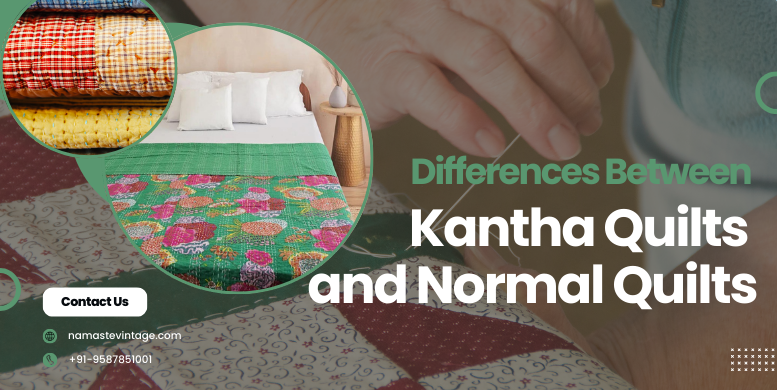Quilts are an essential product for comfort and warmth during the cold seasons, though not all quilts are the same. Here, we will look at Kantha Quilts and Normal Quilts, each of which has characteristics that differ from the other. In this section, we will see the differences existing between these quilts in manufacturing process, materials, uses, and much more.
Differences in the Manufacturing Process
One of the big differences between Normal Quilts and Kantha Quilts is how these are manufactured. Usually, normal quilts have lots of machines involved during manufacture, while a basic standard quilting technique can be seen wherein two fabric layers are stitched together having an intermediate layer of batting sandwiched between them. Oftentimes, the result is mass-produced within some factories, so the overall shape and pattern are somewhat the same.
On the other hand, Kantha quilts are hand-stitched and developed with an old Indian as well as Bangladeshi form of running stitch called "Kantha". The stitching process involves assembling together several layers of old saris or cotton fabrics having a particular running stitch. Every Kantha quilt is specific and reflects the skill along with creativity of the artisanal. Hand-stitching presents it with a vintage feel of artisanal.
Difference in Material
The most significant difference between Normal Quilts and Kantha Quilts lies in the materials. While Normal quilts generally utilize synthetic or mixed materials, such as polyester, cotton-poly blends, or other commercially available fabrics, the batting is made from synthetic fiber for insulation and thickness.
On the contrary, kantha quilts are made from natural cotton fabric through layering and recycling used cotton saris. The outcome is hence soft and breathable and can be more eco-friendly. They utilize reuse of aged fabrics in making, hence assuring sustainability. As against the woven cotton fabric used for quilts, this kind creates a lighter, less dense form that may be used for warmer regions or as extra layers in cooler seasons.
Differences in Uses
The uses of Normal Quilts and Kantha Quilts also vary according to their characteristics. Normal quilts are thicker and more insulating, so perfect for colder climatic regions. They are usually used as bedding, keeping warmer through the chilly winter nights.
Because the quilts are thinner and so very flexible, Kantha quilts are versatile. It can be used as a light throw or bed spread, or even a nice wall hanging. Their rich colors and the stitch will also make a good home decor accent piece. The quilts are commonly applied as sofa throws or as table runners. People make their interior look very antique and handmade with Kantha quilts.
Conclusion
Generally speaking, Normal Quilts and Kantha Quilts are quilts, both of which vary concerning the quality of and attributes belonging to quilts. A normal quilt is manufactured and is, therefore thick while suitable for cold regions; however, Kantha Quilts are produced entirely by hand and is comparatively light-weight while having uses as not only for its functionality but also its ornamentation purpose.
Given these unique features regarding materials that use sustainable features along with artistic and unique design, Kantha Quilts offer excellent possibilities for environmentally friendly additions for homes. Whether you need warmth or a touch of tradition, it is helpful to know the differences to decide which quilt is perfect for your lifestyle.



